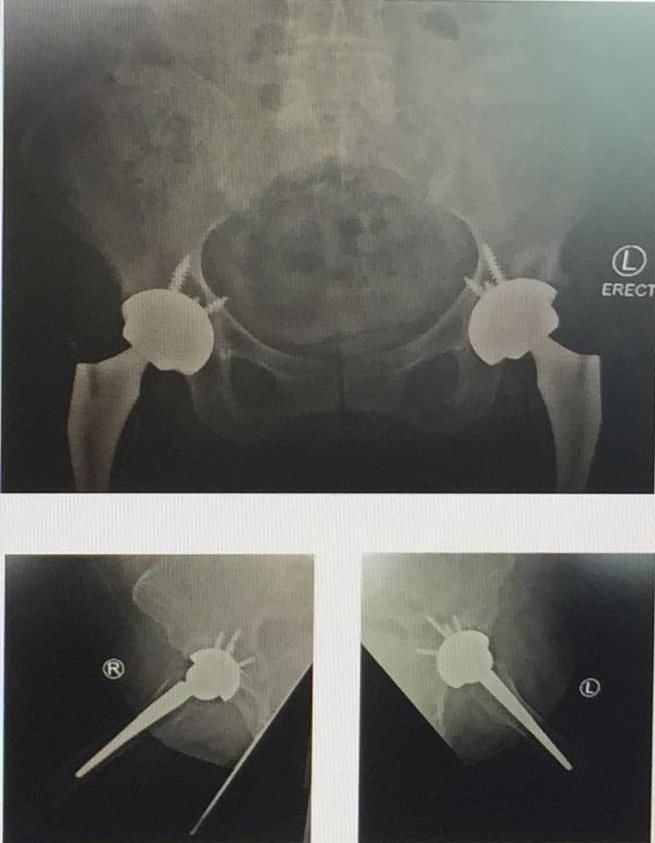Staged hip replacement
This 67-year-old lady presented with worsening bilateral hip pain. Her symptoms were primarily in the groin with pain moving to the knee. We call this referred pain. This is due to the nerve innervation between the hip and the knee being shared giving a sense of perception that the pain is originating from the knee. However, due to severe hip pathology, the patient was having irritation of the pain fibers tricking the brain into thinking that the pain is from the knee. This patient has been having severe pain affecting her walking and making it difficult to perform rotational activities. This then makes it very difficult for other activities of daily living including toileting as well as sitting comfortably on a regular chair. In a setting like Singapore, where there are many stairs to clear, the patient will find it often very difficult to negotiate due to the lack of hip flexion.
Patient came to consult Dr Sathappan with regards to a view of surgery. She has had consults with other doctors before but she had significant apprehension due to persistent pain both in the hips and knees. A thorough physical examination was done and clinical history was also taken. In patients with severe hip disease, they often find it difficult to do clipping of toenails. She in fact confirmed this and even wearing of dresses and clothes as well as wearing of shoe wear was with much difficulty. The functional debilitation from hip can be very severe and she was experiencing it particularly so in the last 1 year. Radiographs were also done which showed that there was also concomitant osteoarthritis of the knees. But the amount disease was severe in both the hips and in particular the right more than the left hip.

Following evaluation of the X-rays, it was discussed with the patient that there are 2 options to be considered. One, undergoing a staged bilateral hip replacement as opposed to doing a simultaneous hip replacement at the same instance. The decision for this has to be done based on functionality as well as the clinical perioperative status of the patient. Even though the patient was perioperatively well, she had reasonable left hip movement. Therefore, after an informed discussion was made for proceeding with a staged right side hip replacement first.
At surgery, there was significant amount of hip arthritis with bone cysts seen as shown in the radiographs. In this patient, where she is a very active individual, she then underwent hip replacement with a placement of a trabecular metal cup, and the inner bearing was fitted with a polyethylene liner. This polyethylene liner is highly crosslinked so that the wear characteristics of this can last her for easily 20 years and beyond. However, for the femoral part, the head bearing surface used was ceramic.
In most of his patients, Dr Sathappan uses either a ceramic on poly or ceramic on ceramic articulation. In hip replacement, the important deciding factors are patient’s functionality and clinical outcome with regards to surgery. In young patients, it is often preferred to use ceramic on ceramic articulations since the wear characteristics can have a longevity of easily 25 – 30 years. But where there is a complex hip replacement requiring multiple permutations of the bearing surface, the best choices remain with metal on poly and ceramic on poly options. This is because, during hip replacement, the primary goal for the surgeon would be to give functionality i.e. improve range of movement, hip stability to prevent dislocation and at the same time to equalize the limb length as much as possible.
This patient underwent initial right hip replacement surgery with good clinical outcome. She was able to ambulate within the next day and was discharged by day 3 after procedure. She managed to completely wean off all walking aids within 2 weeks from surgery and returned to work within 3 weeks from the procedure.
Due to her good recovery, she was very keen for the contralateral side to be operated which she underwent in 4 months’ time. Post-procedure, she was started on rehabilitation therapy and has recovered very well. In this patient, there is a residual problem of knee arthritis. Her symptoms of the hips were so severe that having undergone good hip replacement surgery, it has delayed and put aside the need for any interventional knee surgery. Dr Sathappan has offered her to consider viscosupplementation should the symptoms worsen in the future.

Share this blog via:





